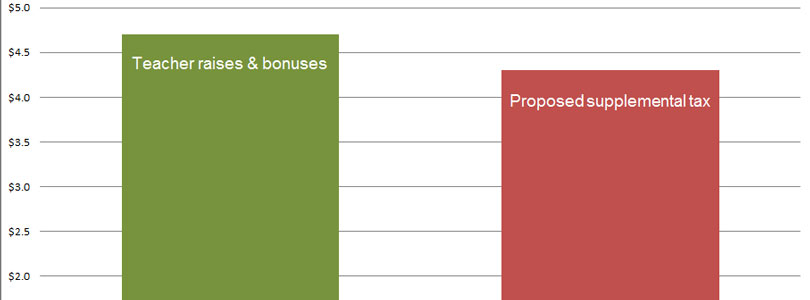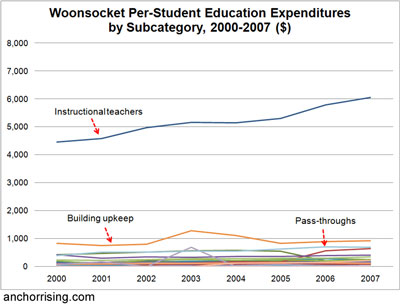Woonsocket Teachers Receive $4.7 Million in Raises and Bonuses in Current Contract
On Monday, April 2, the Woonsocket City Council will meet at the high school to vote on a supplemental tax bill representing a 13% increase and intended to bring in a quick $4.3 million in revenue.
Woonsocket’s financial troubles have been somewhat unique in recent Rhode Island history in the degree to which a tax increase has rushed to the front of proposed solutions. In large part, that’s a function of the speed with which the city has had to react to news from the school department that its projected surplus had transformed into a multi-million-dollar deficit. Only a new tax bill or employee cut would rapidly enough to meet the looming deadline for action. The latter would affect a smaller number of people and run the risk that they’ll simply stop working.
The city has also experienced several years of large deficits on the school side, which have brought concessions from the largest labor union in town, that of the teachers. They now pay 20% of their health insurance premiums and carry a $500 deductible. Their pay has not gone up as much as Rhode Island practice has usually ensured. Additionally, the fact that the schools are running “paperless,” as City Council President John Ward put it on the Dan Yorke Show recently, evokes the image of teachers spending their own money for supplies.
Certainly, none can say that Woonsocket teachers have been leading the state in expanded remuneration, recently. However, neither can one say that they “haven’t had a raise in five years,” which is what RI Federation of Teachers President Frank Flynn declared at a labor presentation at the high school, last week.
That such a statement sounds credible at all is an indication that the discussion of public-school teacher pay has been distorted. Most of the ways in which teachers’ salaries go up, automatically or otherwise, are not considered raises, even though most private-sector employees would recognize them as such.
The most significant raises that teachers get throughout their careers are the step increases that apply annually to their first decade of employment. By the three-year contract covering Woonsocket teachers beginning in the autumn of 2010, those increases are as shown in the following table.
| Step |
Base salary ($)
|
Increase from previous step (%)
|
# of teachers currently at step
|
|
1
|
39,311
|
4
|
|
|
2
|
40,621
|
3.33
|
15
|
|
3
|
41,931
|
3.22
|
15
|
|
4
|
43,898
|
4.69
|
5
|
|
5
|
46,517
|
5.97
|
19
|
|
6
|
49,794
|
7.04
|
19
|
|
7
|
53,070
|
6.58
|
14
|
|
8
|
57,001
|
7.4
|
22
|
|
9
|
60,801
|
6.68
|
36
|
|
10
|
68,984
|
13.46
|
351
|
| Note: Because step 10 is the last step, not all 351 teachers currently on it received their final increase within the last two years. (An estimated 42 of them have.) They do, however, become eligible for longevity bonuses beginning the following year. | |||
Teachers already at step 10 also receive longevity bonuses, which ensure a much smaller raise between $200 and $400 every five years. Although the district did not provide the number of teachers at each stage of longevity, the Current was able to glean that information from another spreadsheet listing every teacher and his or her current status. (The numbers presented from that data set here are estimates because some teachers were listed twice; some positions are vacant; and various other factors made it difficult to compile an accurate tally.)
From the table and the longevity data, it’s possible to estimate at $4.7 million the total dollar amount of raises and salary bonuses that the teachers have collected and expect to collect during the 2010-2011 to 2012-2013 school years. That total breaks down as follows:
- Assuming no new hires outside of the first step, 145 teachers currently at step 9 or below received an average of a 5.8% raise over the last year, with 130 receiving an average of a 12.2% raise over the past two years, for a total two-year increase of $803,105.
- An estimated 42 teachers received the 13.5% raise to step 10 over the past two years, with half receiving another $400 raise moving into the first longevity category, for a two-year total of $352,086. (The estimated count derives from dividing the total number of teachers in the first longevity group by five.)
- Longevity payments to teachers already at step 10 increased by an estimated $15,500 over the past two years.
- The total known and estimated step and longevity raises for the upcoming school year will be $645,499.
- According to their contract, on June 30, 2013, the 338 teachers with higher educational credentials than a bachelor’s degree will receive bonuses ranging from $1,471 to $4,553, currently on target to total $1,139,929.
- These increases compound (i.e., the increases received year one count three times, year two twice, and year three once) to equal $4.7 million.
These are the total raises and bonuses that the teaching staff will receive automatically, simply based on the passage of time. Achieving higher education degrees can boost their salaries as follows: 2.10% for 30 additional credits (B+30), 4.75% for a master’s, 5.25% for M+15, 6.00% for M+30, 6.25% for CAGS, 6.5% for a Ph.D. Up to five teachers at a time (each having seven years of employment with the district) can take a two-semester sabbatical at half of pay to pursue higher education and return the following year without losing any progress in the step system. (That is, he or she returns two steps up from the one that he or she left.)
For example, a teacher who finishes his or her seventh year on the job with half of the credits required for a master’s degree ends has earned an annual $53,070 during the school year. While on sabbatical for the next year to finish the degree, he or she will be paid at a $28,501 annual rate. Upon returning, his or her salary will be $64,078, or 21.7% higher than his or her last full-time year of work.
Teachers can also achieve increases in their pay by becoming department heads, coaching, or leading extracurricular activities.
Such arrangements, added to the prior practice of applying an upward “cost of living adjustment” to all steps each year contributed to the trend in per-pupil expenditures illustrated in the following chart, covering the period before the five years of “no raises”:
[Note: An earlier version of this post, published for about thirty minutes, did not compound the teacher raises and therefore inaccurately presented the total cost as $3.0 million.]



